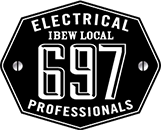No. We are not going to interpret the significance of the fictional character and the main antagonist, Hyman Roth, in the 1974 film The Godfather, Part II. Nor are we speaking about Indiana’s own Diamond Dave. (Hey, did you know that when David stopped touring both as a solo artist or as the front man for VH, he became a state-licensed NYC EMT and went on hundreds of EMS calls in the Bronx in the late 90’s? Talk about giving back.)
Rather, what we are talking about is the IBEW Local 697 Defined Contribution Plan’s 401(k) Roth feature.
What is that, you ask? Well, the Plan’s Roth 401(k) feature is not an investment itself, but a way that participants of the Plan can generate tax-free income in retirement. In other words, the Roth 401(k) provides individuals with the option to contribute to their retirement savings with after-tax dollars, thus allowing for tax-free growth and withdrawals in retirement.
Yes. You read that correctly. All the returns the investments will earn over the years are tax free earnings. Of course there are caveats. This is, after all, a retirement plan, authorized by the United States Congress under the Internal Revenue Code, Section 402(a). So, in order to be tax free, the withdrawals need to be qualified.
Some other features of this Plan’s Roth 401(k) feature is that, as long as a participant has earned income for the year, participants can continue adding after-tax dollars to their Roth 401(k).
More importantly, Roth 401(k’s) are not subject to required minimum distributions (RMDs) once a participant reaches age 73 (75 for people born in 1960 or later). That means that participants can continue growing their retirement savings tax-free until they need it.
Moreover, and not unlike the tax-deferred side of the Defined Contribution Plan, if a participant does not utilize all of their Roth 401(k) savings, they can pass it on to a spouse or another beneficiary when they pass away.
Let’s not forget that the Roth 401(k) contribution limit in 2025 is $23,500 (plus a $7,500 catch-up contribution for savers fifty (50) and older). Those between sixty (60) and sixty-three (63) years old are eligible for a “super catch-up contribution” of up to $11,250 in 2025
But, if you are going to remember anything from this piece, remember these two things; Roth 401(k’s) are funded with after-tax dollars, and participants will not pay taxes on qualifying distributions. The reverse is true on the employer contributions that are going into your Defined Contribution account. Those investment’s grow tax deferred until retirement, are subject to RMD’s, and withdrawals are taxed as ordinary income.
Oh yeah – two more things to remember. Because of taxes, it is better to have both tax free and a tax deferred accounts, than just a tax deferred account. Just as important, if you have not set up an account previously, the best time to establish a Roth account is today. Of course, you don’t have to do that through the Plan, you can accomplish that elsewhere. The important thing is to just do it.
But that later is up to you.
To learn how to make contributions into either the Voluntary or Roth segments of the Defined Contribution Plan call the Fund Office at 219-940-6181 or enter https://www.ibew697benefits.com/annuity/ into your browser and download one of the forms off the Defined Contribution website.
